As all connoisseurs of animation know, a storyboard is the succession of drawings used during the pre-production of an animated film (and very often in live-action too) intended to visualise the story and to plan the whole layout of the movie, bringing everyone onto the same page in attaining the director’s vision on screen.
Storyboarding is Pixar’s Enrico Casarosa’s [below left] trade, and he just happens to have applied it most recently to Disney/Pixar’s current release, the critically acclaimed box-office hit Ratatouille. Jérémie Noyer’s Media Magic headed Emeryville way to speak with Enrico about his career, influences and rodent chefs…

Animated Views: I’m very glad to be able to speak with you and very excited about that because I’m a great Pixar fan and I found Ratatouille just fantastic; really, really amazing.
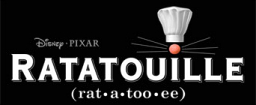 Enrico Casarosa: Yeah, I’m glad you enjoyed it. It’s just been great to see everybody’s reactions to it.
Enrico Casarosa: Yeah, I’m glad you enjoyed it. It’s just been great to see everybody’s reactions to it.
AV: First of all, can you tell me a little about your background, your Italian origins, and what led you to go and study in New York? I believe animation was not your first calling?
EC: Right! When I got out of college I actually started studying engineering so I was actually going down a very different path, but I actually spent most of my time sketching on my books more than studying them. So I eventually turned to illustration in Milan, for one year. You know, I grew up with a lot of Japanese cartoons, which are very similar in a way. I always loved Miyazaki’s work and a lot of his first TV series were on. So I fell into animation from illustration…I loved to draw and animation was one of my interests, and I had a friend who was starting some animation courses in New York, so the first thing I did was go to Boston for a summer workshop in animation at the school of the Museum of Fine Arts and that was really fun got the chance to study all the drawings around and then I ended up in New York, at several schools actually, here and there, but never finished one degree.
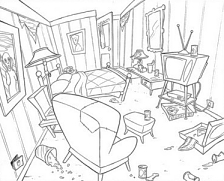 I studied at the School of Visual Arts and Animation, and at the Fashion Institute of Technology in illustration, which actually didn’t have a whole lot to do with animation, but I think to some degree it kind of does, especially fashion illustration which is very creative and full of movement. So then I started working in New York in animation.
I studied at the School of Visual Arts and Animation, and at the Fashion Institute of Technology in illustration, which actually didn’t have a whole lot to do with animation, but I think to some degree it kind of does, especially fashion illustration which is very creative and full of movement. So then I started working in New York in animation.
AV: For Jumbo Pictures?
EC: Yes! I was working on Saturday morning cartoons. I was designing backgrounds, designing props and characters and while I was designing I slowly got more and more interested in stories, and got more excited by storyboarding.
AV: And I read that you started drawing storyboards for the 101 Dalmatians TV series?
EC: Yes, that’s correct. I was working for Disney then.
AV: What led you to the art of storyboarding?
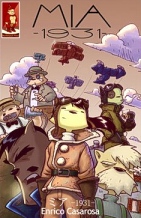 EC: You know I think to a certain degree I felt like I had a certain amount of input, and think the storyboarding was certainly a little bit more fun. It enabled me to convey ideas and go back to things that I loved like beautiful composition and beautiful storytelling; I was always going back and looking at Miyazaki’s work and put that in my work, and there was no way to just do that with design. So it came from a wish to tell stories, and maybe a little bit was from my passion for comics. I’m a big comics fan. It’s storyboarding on the page.
EC: You know I think to a certain degree I felt like I had a certain amount of input, and think the storyboarding was certainly a little bit more fun. It enabled me to convey ideas and go back to things that I loved like beautiful composition and beautiful storytelling; I was always going back and looking at Miyazaki’s work and put that in my work, and there was no way to just do that with design. So it came from a wish to tell stories, and maybe a little bit was from my passion for comics. I’m a big comics fan. It’s storyboarding on the page.
AV: What would be the most important qualities that a good storyboard artist should have?
EC: Well ultimately it’s a lot about ideas. There are various kinds of storyboard artists and even here at Pixar we have people that can be a little more specialised in gags, but an excellent storyboard artist can fire through it all: from drama to funny drawings, and a way to tell stories with the drawing. Very often you see beautiful drawings that don’t quite convey story quickly.
AV: After television you got to Blue Sky Studios, working on the first Ice Age, so what was that change like, going from TV to a feature?
EC: Well there’s a little bit of a divide here in the US between TV animation and feature animation, so it was very challenging to take the job without much experience in this situation. So I had to throw myself into going there, given most of my experience was in TV, storyboarding somebody else’s scripts. It’s very hard for people to see your input and to tell what you came up with.
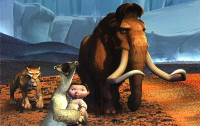 It was different going to a feature because I was being asked to come up with a situation and write something and invent a story, so it’s kind of a challenge going there, quite a big switch, and it wasn’t easy to make. But it certainly was worth it, for me in my career, where without that job I would never have made it to where I am now at Pixar.
It was different going to a feature because I was being asked to come up with a situation and write something and invent a story, so it’s kind of a challenge going there, quite a big switch, and it wasn’t easy to make. But it certainly was worth it, for me in my career, where without that job I would never have made it to where I am now at Pixar.
AV: Which were your scenes in Ice Age, and how was it working with Chris Wedge?
EC: Working with Chris Wedge was really fun, he’s pretty open and he worked a little bit in over storyboarding for me. I did a lot there on the ending, when the baby goes home with the humans. I did a lot of work with the baby, a lot of gags, the big snowball gag, which is mine. When an audience laughs at something like that it’s pretty satisfying. But in storyboarding unfortunately, there’s always a difficulty finding all the scenes you have worked on because we pass them around all the story men, so you’re going to find a lot of drawings from a lot of different people. Sometimes you end up with something in a scene a little more than others.
AV: Why, how and when did you arrive at Pixar?
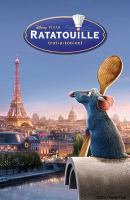 EC: The way I arrived at Pixar is kind of interesting. I was making comics with a few friends, and Ronnie Del Carman, who’s become a very good friend here, and who is head of story here at Pixar and was head of story on Finding Nemo at the time, he knew my work from comics. We started exchanging emails and kind of became friends, and then a position opened for Ratatouille. He was good friends with Jim Capobianco who was the head of story, for Ratatouille at the time, and he said ‘well maybe you should send in your portfolio’. So I sent in the portfolio and then after an amount of time – it wasn’t right away, it was around six months – waiting for the right time for the company to be up and running on it, and I think Jim was the only person working on Ratatouille at the time, so I was the first story artist to join them and certainly in that job of starting development. And they probably figured the fact I was European that it would probably help me storyboard a movie set in Paris. So I started work on it and things came out from there.
EC: The way I arrived at Pixar is kind of interesting. I was making comics with a few friends, and Ronnie Del Carman, who’s become a very good friend here, and who is head of story here at Pixar and was head of story on Finding Nemo at the time, he knew my work from comics. We started exchanging emails and kind of became friends, and then a position opened for Ratatouille. He was good friends with Jim Capobianco who was the head of story, for Ratatouille at the time, and he said ‘well maybe you should send in your portfolio’. So I sent in the portfolio and then after an amount of time – it wasn’t right away, it was around six months – waiting for the right time for the company to be up and running on it, and I think Jim was the only person working on Ratatouille at the time, so I was the first story artist to join them and certainly in that job of starting development. And they probably figured the fact I was European that it would probably help me storyboard a movie set in Paris. So I started work on it and things came out from there.
AV: Since you were there at the beginning of conception for Ratatouille, what was the storyline at that point, and how did you work with original director Jan Pinkava and handle the switch to Brad Bird?
EC: Well each story here at Pixar goes through so much change; we really, really are struggling to tell the best story we can, so in each movie – and I’ve been working on another movie since – there’s just a load of writing, re-writing and re-writing. We often kid around in our job, and say it should actually be called re-storyboarding! But at the beginning it was very much more of a synopsis or the beginning of a script. All the elements were there, it’s still the same movie, but it was a really great time because it was a moment where we could really start, for example, exploring how to convey the tone.
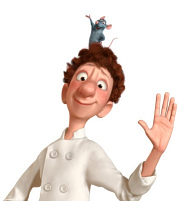 It was always such a non-visual concept so some of the first challenges were to do with how do we show things and make them amazing, and that’s how we started brainstorming ideas like flashbacks and things like that, but it was a very exciting time. When Brad Bird came on board and took over, having him seeing it made us re-reach, and he added some amazing writing, so it was eventually pretty organic. It was pretty long, I was on it for four years, but at Pixar here we just take so much time to tell the best story we can. I think that it was a good story and then they wanted it to be an amazing story, and Brad really made it sing.
It was always such a non-visual concept so some of the first challenges were to do with how do we show things and make them amazing, and that’s how we started brainstorming ideas like flashbacks and things like that, but it was a very exciting time. When Brad Bird came on board and took over, having him seeing it made us re-reach, and he added some amazing writing, so it was eventually pretty organic. It was pretty long, I was on it for four years, but at Pixar here we just take so much time to tell the best story we can. I think that it was a good story and then they wanted it to be an amazing story, and Brad really made it sing.
AV: When you talk about brainstorming, does that mean you sit around a table with the story artists, the producer and the director and just throw ideas out from nowhere? Is it that kind of process?
EC: It kind of varies…storyboarding has a unique range. When we get to brainstorming it’s usually the question of having one problem, which needs to be explored more. So what we do is gather the head of story and a lot of the other artists into a room to start drawing and start throwing ideas around. The director is sometimes there, some not. It’s been a way of putting together brains to solve a problem, at a very specific time it can happen. Other times it really varies from having to storyboard and visual the script, which is probably what we do most of the time, more often than not. Brad Bird or any of the writers come up with six or seven pages or two or three pages – it’s never specific – of script, and you just go straight ahead and board it, visualise it and go to storyboard the whole sequence. So very often there’s a range between coming up with something or just realising what’s already on the page. So that’s the fun part, there’s a lot of variety in our work.
 AV: So when the scripts arrive, they’re not set in stone, they’re still open to any other ideas, be they visual or humoristic, as long as they add to the intended story?
AV: So when the scripts arrive, they’re not set in stone, they’re still open to any other ideas, be they visual or humoristic, as long as they add to the intended story?
EC: Yeah, I think so. With most directors I’ve worked with there’s always the feeling of getting the page and if there is something that can be added or something we can have a discussion about then definitely the director is open to that. Now ultimately we feel strongly that if we are helping the director’s vision that’s the important thing. We don’t want too many in the kitchen, but there’s definitely always space to go ‘hey what if we do this’ in the scene. For instance in a sequence I was boarding all we had was Rémy walking down the street, and he’s all really confident and happy that he’s going to work at the restaurant, and I just added the fact that he just kind of flicks at somebody offscreen, you know, all confident and he points to them, and this bicycle comes by and the guy hits the car behind him. I just pitched that to Brad, and it’s a good example of how doing this can be fun, and Brad was completely open to that. It doesn’t always mean that it stays in the movie, but when you see something like that on the screen and people laugh and it makes you feel good about it. The script was so amazing that it wouldn’t happen very often, with the beautiful writing, so it’s really more about making a really good scene and then taking a crack at adding here and there if we can.
AV: When you draw your storyboards, do you already have an idea of the design of the characters or are you drawing from your own imagination because nothing has been finalised at that time?
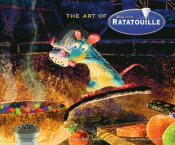 EC: At the beginning there were some pretty good designs, and you can see a lot of them in The Art Of Ratatouille. They were still preliminary, so there is no actual set-in-stone design, but you have a pretty good idea from simply following the descriptions, for example Carter Goodrich, who was doing large parts at the beginning of design, and so we were all pretty clear…he did beautiful renderings of the cooks. They changed a bit throughout the design process, of course there are great designers and sketch artists here that draw in their kind of own way so they pass through designers and then certainly again into the 3D character. So there’s a little bit of change but we did have a certain amount of direction from the illustration. That can vary, you know, sometimes we have just one drawing or one little sketch, and storyboarding is very unique because not everything is exact or the best quality, because very often the model is still being tweaked. But we did have pretty good designs and Carter Goodrich’s work really stood out on Ratatouille.
EC: At the beginning there were some pretty good designs, and you can see a lot of them in The Art Of Ratatouille. They were still preliminary, so there is no actual set-in-stone design, but you have a pretty good idea from simply following the descriptions, for example Carter Goodrich, who was doing large parts at the beginning of design, and so we were all pretty clear…he did beautiful renderings of the cooks. They changed a bit throughout the design process, of course there are great designers and sketch artists here that draw in their kind of own way so they pass through designers and then certainly again into the 3D character. So there’s a little bit of change but we did have a certain amount of direction from the illustration. That can vary, you know, sometimes we have just one drawing or one little sketch, and storyboarding is very unique because not everything is exact or the best quality, because very often the model is still being tweaked. But we did have pretty good designs and Carter Goodrich’s work really stood out on Ratatouille.
AV: You just mentioned the book The Art Of Ratatouille and in there we can see a couple of your storyboards: from near the end where the rats are readying to cook in Gustau’s restaurant, and a drawing from Rémy’s cooking fantasy sequence. Can you tell us more about those two moments?
 EC: Yeah, the idea of the rats cooking was actually something in Brad’s version of the movie was very similar to what we had. I didn’t storyboard the final version of it, but that was one of the elements they used from what we used to have. It was always a kind of a challenging sequence in some ways but they always wanted rats all over the kitchen, which is in some way crazy and exciting, and disgusting! We right away came up with the idea of the dishwasher, you know, that cleaned them all. It was a lot of fun and it’s also about coming up with ideas for all the rats, like the rat skating on butter in the pan or the big guy punching the steak, so it was a lot of fun to brainstorm and come up with a lot of ideas for these rats, these little rats who cook around the kitchen.
EC: Yeah, the idea of the rats cooking was actually something in Brad’s version of the movie was very similar to what we had. I didn’t storyboard the final version of it, but that was one of the elements they used from what we used to have. It was always a kind of a challenging sequence in some ways but they always wanted rats all over the kitchen, which is in some way crazy and exciting, and disgusting! We right away came up with the idea of the dishwasher, you know, that cleaned them all. It was a lot of fun and it’s also about coming up with ideas for all the rats, like the rat skating on butter in the pan or the big guy punching the steak, so it was a lot of fun to brainstorm and come up with a lot of ideas for these rats, these little rats who cook around the kitchen.
AV: At that point the kitchen isn’t as much as a place of work but also a playground. That must have been fun coming up with what a rat could get up to in that kind of environment.
EC: Oh absolutely. We had the challenge throughout the movie, even with Rémy, on how we could have fun with him, how can we cook in a different way but make it work, so we had to decide that first. Now, for the cooking fantasy sequence, that was hard. That sequence is pretty famous around here because I did it 15 times at least…it was one of those sequences that stayed with me a long time!
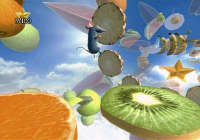 It was originally a very silly dream sequence, of course, for Rémy, but we wanted it to be valid and it was great to bring something of Miyazaki about it…we had flying colanders and he was flying in the sky with steam clouds. We had ideas of a Winter Wonderland where he would be making snow angels in sweet sugar, so that’s what some of the drawings in the book are. It was really a lot of fun to try, and we went in many directions, with crazy cooking and I think seriously it stayed in the video game in the part where you’re running around in the sky!
It was originally a very silly dream sequence, of course, for Rémy, but we wanted it to be valid and it was great to bring something of Miyazaki about it…we had flying colanders and he was flying in the sky with steam clouds. We had ideas of a Winter Wonderland where he would be making snow angels in sweet sugar, so that’s what some of the drawings in the book are. It was really a lot of fun to try, and we went in many directions, with crazy cooking and I think seriously it stayed in the video game in the part where you’re running around in the sky!
So there were various degrees in story progression from when we had it from Jan in story reels and I don’t think there was that much of a need for that sequence in Brad’s version, but I think it might make it out on a DVD or something.
AV: Again from the book, I read that you were also involved in layout?
EC: Not exactly. What you find in the book is that someone takes the storyboard and then does the painting over it, so you can see it in color. For example on the book’s cover, Harley Jessup, the art director, did the painting but they also gave credit to me because that was based on a story beat I had drawn. A story beat is something I did a lot in the beginning, which is when you don’t have the entire movie storyboarded yet but you’re trying to sell the story, you have beats. From just one image you try and convey the feeling of the whole sequence, or maybe two or three drawings that show the whole sequence. And I had a lot of fun with Jan Pinkava in the beginning on a lot of the story beats, and I think some of those are in the book. For example the one with Rémy cooking on the cover was a drawing of mine that Harley colored, so it’s not exactly that I did layout, because layout is much more of a technical thing here, where they take our drawings and it’s the first step into the computer 3D world. So what that means is that some of the amazing artists here took some of our boards, some of our drawings, some of mine, some of the other storyboard artists’, and colored them and from that they can develop the lighting.
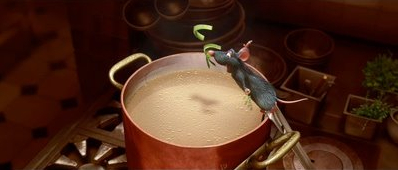 AV: So it’s a very collaborative process!
AV: So it’s a very collaborative process!
EC: Yeah, it really is. There’s no doubt about it, and that’s what’s exciting about being in a place like Pixar. In the arts there are just so many jobs that are pretty solitary, but at Pixar we just come to work and we inspire each other and do a lot of work together which is pretty amazing, you know. I can’t think of a creative process that has this many people involved.
AV: Talking about collaboration, you mentioned Ronnie Del Carmen, who you work with inside and outside of Pixar. Can you tell us about working with him either on the SketchCrawl project, or the book Three Trees Make A Forest?
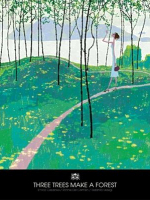 EC: Once I arrived at Pixar I immediately got started talking about books, comics, things I have a passion about. I had a little experience because I had self-published some comics, and Ronnie knew about that work, and his interests were the same, so we started collaborating and using the same printers I had been using. We made a book of all our sketches and figure drawings together, and it’s been a ton of fun…we’ve gone more than a couple of times to the Comic-Con, in San Diego, so it’s really about having another outlet for our creativity. The Three Trees Make A Forest book is a great example of that. There’s a third artist in the book, another friend we met, Tadahiro Uesugi. We just admired his work for years and we started talking to him by email, and then we met him a couple of times in Japan…a very friendly person.
EC: Once I arrived at Pixar I immediately got started talking about books, comics, things I have a passion about. I had a little experience because I had self-published some comics, and Ronnie knew about that work, and his interests were the same, so we started collaborating and using the same printers I had been using. We made a book of all our sketches and figure drawings together, and it’s been a ton of fun…we’ve gone more than a couple of times to the Comic-Con, in San Diego, so it’s really about having another outlet for our creativity. The Three Trees Make A Forest book is a great example of that. There’s a third artist in the book, another friend we met, Tadahiro Uesugi. We just admired his work for years and we started talking to him by email, and then we met him a couple of times in Japan…a very friendly person.
We started up a friendship and he came here once, and we went there to visit him and then we organised a show, where we really wanted him to be one of the participants. And that’s where the idea of the Three Trees Make A Forest evolved and we had the artists in LA and we had a lot of fun. It almost took two years, but the publisher made a nice book and we’re very happy with it. It’s the culmination of things we’ve done, and it was the first time we went with a real publisher, which was really nice. We hope to keep on doing that, with more art shows…it’s almost kind of like a little artistic muscle that we don’t use normally, so we love to once in a while just put ourselves in that situation and, you know, say ‘well, what if there was an art show every six months?’, we’ve started thinking. So that’s there, and we’re still making little comics on the side and trying to get them out there.
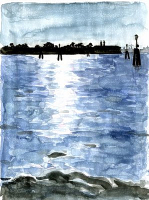 I’ve also just finished The Venice Chronicles, another personal project which I’ve been working on and uploading to my site in single pages for almost a year. I hope to have a print version out there soon.
I’ve also just finished The Venice Chronicles, another personal project which I’ve been working on and uploading to my site in single pages for almost a year. I hope to have a print version out there soon.
With SketchCrawl, that’s a highly different thing. The first time I went out on my own and spent a whole day just drawing. I found it very exhilarating and drew for almost ten hours straight. It was amazing, it just felt so liberating. As artists, we often go around with our sketchbooks in our bags and we always want to draw, but sometimes we don’t get to, not as much as we’d wish. I wanted to change that, so one day I thought I wouldn’t put the book in my bag at all…I’d just draw all day, sketchbook in my hand. Slowly it turned into this thing where other friends came and we did it together, and then I came up with the idea of making a website where we could put the call out to the whole world. We’d decide on a date where we would all go out and all just draw at the same time. It seemed like an interesting idea and we’ve done more and more of those, and there’s some exhilarating about knowing that there’s a certain amount of people that are all doing the same thing at the same time, you know.
It’s been great, and a little bit of an excuse to travel, which is another great way of meeting artists with an interest for sketching and drawing. We just had our last marathon and that was a great success where we raised money for a cause, which is Emergency USA…they’re non-profit, building hospitals throughout foreign countries all over the world. So we raised money by putting on a little art auction, and it works really well. We still put a call out for a World Wide SketchCrawl every other month or so. At one of these in San Francisco we had about 80 people sketching around the city! And with cities all around the globe participating we have hundreds of artists drawing on the same day and sharing this event! It’s just a lot of fun to be out there with all these people drawing around you. It’s been really great. And we’re also super lucky that we’re in a company where they’re very, very open…they recognise that we need this outlet. Pixar are very, very supportive of these activities.
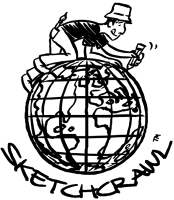 AV: So this openness must contribute to the unique feel of Pixar’s films?
AV: So this openness must contribute to the unique feel of Pixar’s films?
EC: Yeah, absolutely, we’re very lucky to have very smart, open-minded people that welcome these things and recognise that having those chances only makes us better in our work. You know, we’re all artists and whatever creative energy we have needs a certain amount of outlet. And there are screenings, and we have great classes here, and of course the artists’ Pixar University, which is great…we can draw figure drawing twice a week, or go and do yoga, we can sculpture; there’s always something you can go and try. And certainly I think all that helps us, because if you’re going to make movies you need to take a chance to make them different. They are challenging, they’re not just formulaic. It really carries over into making something that’s exciting, something that’s creative.
AV: And now that Ratatouille is finished, are you working on another project at Pixar that we might know about?
EC: Yeah, it has been revealed, and I’m glad so I can tell you! I’ve been working on Up, which has just been announced a few weeks ago, with director Pete Docter from Monsters, Inc, and I’ve been on that project for more than a year. We’re having a lot of fun, and it’s been great working with him, so I’m excited about that one. It’s just exciting again working on movies that are off the beaten track and are different. I just love to work on things like that.
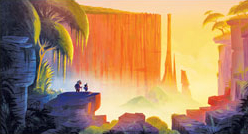
Photos ©Disney/Pixar, and Disney, courtesy of Enrico Casarosa. Photo of Enrico, Ronnie Del Carmen and Tadahiro Uesugi at top courtesy of Ronnie Del Carmen, with our gratitude and admiration! And with very special thanks to Erin Harrison at Pixar.
This article was originally published in French at Media Magic. It is reprinted here by exclusive arrangement and with express permission from its author, Jérémie Noyer. English version ©Animated News & Views.
Storyboarding is Pixar’s Enrico Casarosa’s [below left] trade, and he just happens to have applied it most recently to Disney/Pixar’s current release, the critically acclaimed box-office hit Ratatouille. Jérémie Noyer’s Media Magic headed Emeryville way to speak with Enrico about his career, influences and rodent chefs…

Animated Views: I’m very glad to be able to speak with you and very excited about that because I’m a great Pixar fan and I found Ratatouille just fantastic; really, really amazing.
 Enrico Casarosa: Yeah, I’m glad you enjoyed it. It’s just been great to see everybody’s reactions to it.
Enrico Casarosa: Yeah, I’m glad you enjoyed it. It’s just been great to see everybody’s reactions to it.AV: First of all, can you tell me a little about your background, your Italian origins, and what led you to go and study in New York? I believe animation was not your first calling?
EC: Right! When I got out of college I actually started studying engineering so I was actually going down a very different path, but I actually spent most of my time sketching on my books more than studying them. So I eventually turned to illustration in Milan, for one year. You know, I grew up with a lot of Japanese cartoons, which are very similar in a way. I always loved Miyazaki’s work and a lot of his first TV series were on. So I fell into animation from illustration…I loved to draw and animation was one of my interests, and I had a friend who was starting some animation courses in New York, so the first thing I did was go to Boston for a summer workshop in animation at the school of the Museum of Fine Arts and that was really fun got the chance to study all the drawings around and then I ended up in New York, at several schools actually, here and there, but never finished one degree.
 I studied at the School of Visual Arts and Animation, and at the Fashion Institute of Technology in illustration, which actually didn’t have a whole lot to do with animation, but I think to some degree it kind of does, especially fashion illustration which is very creative and full of movement. So then I started working in New York in animation.
I studied at the School of Visual Arts and Animation, and at the Fashion Institute of Technology in illustration, which actually didn’t have a whole lot to do with animation, but I think to some degree it kind of does, especially fashion illustration which is very creative and full of movement. So then I started working in New York in animation.AV: For Jumbo Pictures?
EC: Yes! I was working on Saturday morning cartoons. I was designing backgrounds, designing props and characters and while I was designing I slowly got more and more interested in stories, and got more excited by storyboarding.
AV: And I read that you started drawing storyboards for the 101 Dalmatians TV series?
EC: Yes, that’s correct. I was working for Disney then.
AV: What led you to the art of storyboarding?
 EC: You know I think to a certain degree I felt like I had a certain amount of input, and think the storyboarding was certainly a little bit more fun. It enabled me to convey ideas and go back to things that I loved like beautiful composition and beautiful storytelling; I was always going back and looking at Miyazaki’s work and put that in my work, and there was no way to just do that with design. So it came from a wish to tell stories, and maybe a little bit was from my passion for comics. I’m a big comics fan. It’s storyboarding on the page.
EC: You know I think to a certain degree I felt like I had a certain amount of input, and think the storyboarding was certainly a little bit more fun. It enabled me to convey ideas and go back to things that I loved like beautiful composition and beautiful storytelling; I was always going back and looking at Miyazaki’s work and put that in my work, and there was no way to just do that with design. So it came from a wish to tell stories, and maybe a little bit was from my passion for comics. I’m a big comics fan. It’s storyboarding on the page.AV: What would be the most important qualities that a good storyboard artist should have?
EC: Well ultimately it’s a lot about ideas. There are various kinds of storyboard artists and even here at Pixar we have people that can be a little more specialised in gags, but an excellent storyboard artist can fire through it all: from drama to funny drawings, and a way to tell stories with the drawing. Very often you see beautiful drawings that don’t quite convey story quickly.
AV: After television you got to Blue Sky Studios, working on the first Ice Age, so what was that change like, going from TV to a feature?
EC: Well there’s a little bit of a divide here in the US between TV animation and feature animation, so it was very challenging to take the job without much experience in this situation. So I had to throw myself into going there, given most of my experience was in TV, storyboarding somebody else’s scripts. It’s very hard for people to see your input and to tell what you came up with.
 It was different going to a feature because I was being asked to come up with a situation and write something and invent a story, so it’s kind of a challenge going there, quite a big switch, and it wasn’t easy to make. But it certainly was worth it, for me in my career, where without that job I would never have made it to where I am now at Pixar.
It was different going to a feature because I was being asked to come up with a situation and write something and invent a story, so it’s kind of a challenge going there, quite a big switch, and it wasn’t easy to make. But it certainly was worth it, for me in my career, where without that job I would never have made it to where I am now at Pixar.AV: Which were your scenes in Ice Age, and how was it working with Chris Wedge?
EC: Working with Chris Wedge was really fun, he’s pretty open and he worked a little bit in over storyboarding for me. I did a lot there on the ending, when the baby goes home with the humans. I did a lot of work with the baby, a lot of gags, the big snowball gag, which is mine. When an audience laughs at something like that it’s pretty satisfying. But in storyboarding unfortunately, there’s always a difficulty finding all the scenes you have worked on because we pass them around all the story men, so you’re going to find a lot of drawings from a lot of different people. Sometimes you end up with something in a scene a little more than others.
AV: Why, how and when did you arrive at Pixar?
 EC: The way I arrived at Pixar is kind of interesting. I was making comics with a few friends, and Ronnie Del Carman, who’s become a very good friend here, and who is head of story here at Pixar and was head of story on Finding Nemo at the time, he knew my work from comics. We started exchanging emails and kind of became friends, and then a position opened for Ratatouille. He was good friends with Jim Capobianco who was the head of story, for Ratatouille at the time, and he said ‘well maybe you should send in your portfolio’. So I sent in the portfolio and then after an amount of time – it wasn’t right away, it was around six months – waiting for the right time for the company to be up and running on it, and I think Jim was the only person working on Ratatouille at the time, so I was the first story artist to join them and certainly in that job of starting development. And they probably figured the fact I was European that it would probably help me storyboard a movie set in Paris. So I started work on it and things came out from there.
EC: The way I arrived at Pixar is kind of interesting. I was making comics with a few friends, and Ronnie Del Carman, who’s become a very good friend here, and who is head of story here at Pixar and was head of story on Finding Nemo at the time, he knew my work from comics. We started exchanging emails and kind of became friends, and then a position opened for Ratatouille. He was good friends with Jim Capobianco who was the head of story, for Ratatouille at the time, and he said ‘well maybe you should send in your portfolio’. So I sent in the portfolio and then after an amount of time – it wasn’t right away, it was around six months – waiting for the right time for the company to be up and running on it, and I think Jim was the only person working on Ratatouille at the time, so I was the first story artist to join them and certainly in that job of starting development. And they probably figured the fact I was European that it would probably help me storyboard a movie set in Paris. So I started work on it and things came out from there.AV: Since you were there at the beginning of conception for Ratatouille, what was the storyline at that point, and how did you work with original director Jan Pinkava and handle the switch to Brad Bird?
EC: Well each story here at Pixar goes through so much change; we really, really are struggling to tell the best story we can, so in each movie – and I’ve been working on another movie since – there’s just a load of writing, re-writing and re-writing. We often kid around in our job, and say it should actually be called re-storyboarding! But at the beginning it was very much more of a synopsis or the beginning of a script. All the elements were there, it’s still the same movie, but it was a really great time because it was a moment where we could really start, for example, exploring how to convey the tone.
 It was always such a non-visual concept so some of the first challenges were to do with how do we show things and make them amazing, and that’s how we started brainstorming ideas like flashbacks and things like that, but it was a very exciting time. When Brad Bird came on board and took over, having him seeing it made us re-reach, and he added some amazing writing, so it was eventually pretty organic. It was pretty long, I was on it for four years, but at Pixar here we just take so much time to tell the best story we can. I think that it was a good story and then they wanted it to be an amazing story, and Brad really made it sing.
It was always such a non-visual concept so some of the first challenges were to do with how do we show things and make them amazing, and that’s how we started brainstorming ideas like flashbacks and things like that, but it was a very exciting time. When Brad Bird came on board and took over, having him seeing it made us re-reach, and he added some amazing writing, so it was eventually pretty organic. It was pretty long, I was on it for four years, but at Pixar here we just take so much time to tell the best story we can. I think that it was a good story and then they wanted it to be an amazing story, and Brad really made it sing.AV: When you talk about brainstorming, does that mean you sit around a table with the story artists, the producer and the director and just throw ideas out from nowhere? Is it that kind of process?
EC: It kind of varies…storyboarding has a unique range. When we get to brainstorming it’s usually the question of having one problem, which needs to be explored more. So what we do is gather the head of story and a lot of the other artists into a room to start drawing and start throwing ideas around. The director is sometimes there, some not. It’s been a way of putting together brains to solve a problem, at a very specific time it can happen. Other times it really varies from having to storyboard and visual the script, which is probably what we do most of the time, more often than not. Brad Bird or any of the writers come up with six or seven pages or two or three pages – it’s never specific – of script, and you just go straight ahead and board it, visualise it and go to storyboard the whole sequence. So very often there’s a range between coming up with something or just realising what’s already on the page. So that’s the fun part, there’s a lot of variety in our work.
 AV: So when the scripts arrive, they’re not set in stone, they’re still open to any other ideas, be they visual or humoristic, as long as they add to the intended story?
AV: So when the scripts arrive, they’re not set in stone, they’re still open to any other ideas, be they visual or humoristic, as long as they add to the intended story?EC: Yeah, I think so. With most directors I’ve worked with there’s always the feeling of getting the page and if there is something that can be added or something we can have a discussion about then definitely the director is open to that. Now ultimately we feel strongly that if we are helping the director’s vision that’s the important thing. We don’t want too many in the kitchen, but there’s definitely always space to go ‘hey what if we do this’ in the scene. For instance in a sequence I was boarding all we had was Rémy walking down the street, and he’s all really confident and happy that he’s going to work at the restaurant, and I just added the fact that he just kind of flicks at somebody offscreen, you know, all confident and he points to them, and this bicycle comes by and the guy hits the car behind him. I just pitched that to Brad, and it’s a good example of how doing this can be fun, and Brad was completely open to that. It doesn’t always mean that it stays in the movie, but when you see something like that on the screen and people laugh and it makes you feel good about it. The script was so amazing that it wouldn’t happen very often, with the beautiful writing, so it’s really more about making a really good scene and then taking a crack at adding here and there if we can.
AV: When you draw your storyboards, do you already have an idea of the design of the characters or are you drawing from your own imagination because nothing has been finalised at that time?
 EC: At the beginning there were some pretty good designs, and you can see a lot of them in The Art Of Ratatouille. They were still preliminary, so there is no actual set-in-stone design, but you have a pretty good idea from simply following the descriptions, for example Carter Goodrich, who was doing large parts at the beginning of design, and so we were all pretty clear…he did beautiful renderings of the cooks. They changed a bit throughout the design process, of course there are great designers and sketch artists here that draw in their kind of own way so they pass through designers and then certainly again into the 3D character. So there’s a little bit of change but we did have a certain amount of direction from the illustration. That can vary, you know, sometimes we have just one drawing or one little sketch, and storyboarding is very unique because not everything is exact or the best quality, because very often the model is still being tweaked. But we did have pretty good designs and Carter Goodrich’s work really stood out on Ratatouille.
EC: At the beginning there were some pretty good designs, and you can see a lot of them in The Art Of Ratatouille. They were still preliminary, so there is no actual set-in-stone design, but you have a pretty good idea from simply following the descriptions, for example Carter Goodrich, who was doing large parts at the beginning of design, and so we were all pretty clear…he did beautiful renderings of the cooks. They changed a bit throughout the design process, of course there are great designers and sketch artists here that draw in their kind of own way so they pass through designers and then certainly again into the 3D character. So there’s a little bit of change but we did have a certain amount of direction from the illustration. That can vary, you know, sometimes we have just one drawing or one little sketch, and storyboarding is very unique because not everything is exact or the best quality, because very often the model is still being tweaked. But we did have pretty good designs and Carter Goodrich’s work really stood out on Ratatouille.AV: You just mentioned the book The Art Of Ratatouille and in there we can see a couple of your storyboards: from near the end where the rats are readying to cook in Gustau’s restaurant, and a drawing from Rémy’s cooking fantasy sequence. Can you tell us more about those two moments?

AV: At that point the kitchen isn’t as much as a place of work but also a playground. That must have been fun coming up with what a rat could get up to in that kind of environment.
EC: Oh absolutely. We had the challenge throughout the movie, even with Rémy, on how we could have fun with him, how can we cook in a different way but make it work, so we had to decide that first. Now, for the cooking fantasy sequence, that was hard. That sequence is pretty famous around here because I did it 15 times at least…it was one of those sequences that stayed with me a long time!
 It was originally a very silly dream sequence, of course, for Rémy, but we wanted it to be valid and it was great to bring something of Miyazaki about it…we had flying colanders and he was flying in the sky with steam clouds. We had ideas of a Winter Wonderland where he would be making snow angels in sweet sugar, so that’s what some of the drawings in the book are. It was really a lot of fun to try, and we went in many directions, with crazy cooking and I think seriously it stayed in the video game in the part where you’re running around in the sky!
It was originally a very silly dream sequence, of course, for Rémy, but we wanted it to be valid and it was great to bring something of Miyazaki about it…we had flying colanders and he was flying in the sky with steam clouds. We had ideas of a Winter Wonderland where he would be making snow angels in sweet sugar, so that’s what some of the drawings in the book are. It was really a lot of fun to try, and we went in many directions, with crazy cooking and I think seriously it stayed in the video game in the part where you’re running around in the sky!So there were various degrees in story progression from when we had it from Jan in story reels and I don’t think there was that much of a need for that sequence in Brad’s version, but I think it might make it out on a DVD or something.
AV: Again from the book, I read that you were also involved in layout?
EC: Not exactly. What you find in the book is that someone takes the storyboard and then does the painting over it, so you can see it in color. For example on the book’s cover, Harley Jessup, the art director, did the painting but they also gave credit to me because that was based on a story beat I had drawn. A story beat is something I did a lot in the beginning, which is when you don’t have the entire movie storyboarded yet but you’re trying to sell the story, you have beats. From just one image you try and convey the feeling of the whole sequence, or maybe two or three drawings that show the whole sequence. And I had a lot of fun with Jan Pinkava in the beginning on a lot of the story beats, and I think some of those are in the book. For example the one with Rémy cooking on the cover was a drawing of mine that Harley colored, so it’s not exactly that I did layout, because layout is much more of a technical thing here, where they take our drawings and it’s the first step into the computer 3D world. So what that means is that some of the amazing artists here took some of our boards, some of our drawings, some of mine, some of the other storyboard artists’, and colored them and from that they can develop the lighting.

EC: Yeah, it really is. There’s no doubt about it, and that’s what’s exciting about being in a place like Pixar. In the arts there are just so many jobs that are pretty solitary, but at Pixar we just come to work and we inspire each other and do a lot of work together which is pretty amazing, you know. I can’t think of a creative process that has this many people involved.
AV: Talking about collaboration, you mentioned Ronnie Del Carmen, who you work with inside and outside of Pixar. Can you tell us about working with him either on the SketchCrawl project, or the book Three Trees Make A Forest?
 EC: Once I arrived at Pixar I immediately got started talking about books, comics, things I have a passion about. I had a little experience because I had self-published some comics, and Ronnie knew about that work, and his interests were the same, so we started collaborating and using the same printers I had been using. We made a book of all our sketches and figure drawings together, and it’s been a ton of fun…we’ve gone more than a couple of times to the Comic-Con, in San Diego, so it’s really about having another outlet for our creativity. The Three Trees Make A Forest book is a great example of that. There’s a third artist in the book, another friend we met, Tadahiro Uesugi. We just admired his work for years and we started talking to him by email, and then we met him a couple of times in Japan…a very friendly person.
EC: Once I arrived at Pixar I immediately got started talking about books, comics, things I have a passion about. I had a little experience because I had self-published some comics, and Ronnie knew about that work, and his interests were the same, so we started collaborating and using the same printers I had been using. We made a book of all our sketches and figure drawings together, and it’s been a ton of fun…we’ve gone more than a couple of times to the Comic-Con, in San Diego, so it’s really about having another outlet for our creativity. The Three Trees Make A Forest book is a great example of that. There’s a third artist in the book, another friend we met, Tadahiro Uesugi. We just admired his work for years and we started talking to him by email, and then we met him a couple of times in Japan…a very friendly person.We started up a friendship and he came here once, and we went there to visit him and then we organised a show, where we really wanted him to be one of the participants. And that’s where the idea of the Three Trees Make A Forest evolved and we had the artists in LA and we had a lot of fun. It almost took two years, but the publisher made a nice book and we’re very happy with it. It’s the culmination of things we’ve done, and it was the first time we went with a real publisher, which was really nice. We hope to keep on doing that, with more art shows…it’s almost kind of like a little artistic muscle that we don’t use normally, so we love to once in a while just put ourselves in that situation and, you know, say ‘well, what if there was an art show every six months?’, we’ve started thinking. So that’s there, and we’re still making little comics on the side and trying to get them out there.
 I’ve also just finished The Venice Chronicles, another personal project which I’ve been working on and uploading to my site in single pages for almost a year. I hope to have a print version out there soon.
I’ve also just finished The Venice Chronicles, another personal project which I’ve been working on and uploading to my site in single pages for almost a year. I hope to have a print version out there soon.With SketchCrawl, that’s a highly different thing. The first time I went out on my own and spent a whole day just drawing. I found it very exhilarating and drew for almost ten hours straight. It was amazing, it just felt so liberating. As artists, we often go around with our sketchbooks in our bags and we always want to draw, but sometimes we don’t get to, not as much as we’d wish. I wanted to change that, so one day I thought I wouldn’t put the book in my bag at all…I’d just draw all day, sketchbook in my hand. Slowly it turned into this thing where other friends came and we did it together, and then I came up with the idea of making a website where we could put the call out to the whole world. We’d decide on a date where we would all go out and all just draw at the same time. It seemed like an interesting idea and we’ve done more and more of those, and there’s some exhilarating about knowing that there’s a certain amount of people that are all doing the same thing at the same time, you know.
It’s been great, and a little bit of an excuse to travel, which is another great way of meeting artists with an interest for sketching and drawing. We just had our last marathon and that was a great success where we raised money for a cause, which is Emergency USA…they’re non-profit, building hospitals throughout foreign countries all over the world. So we raised money by putting on a little art auction, and it works really well. We still put a call out for a World Wide SketchCrawl every other month or so. At one of these in San Francisco we had about 80 people sketching around the city! And with cities all around the globe participating we have hundreds of artists drawing on the same day and sharing this event! It’s just a lot of fun to be out there with all these people drawing around you. It’s been really great. And we’re also super lucky that we’re in a company where they’re very, very open…they recognise that we need this outlet. Pixar are very, very supportive of these activities.
 AV: So this openness must contribute to the unique feel of Pixar’s films?
AV: So this openness must contribute to the unique feel of Pixar’s films?EC: Yeah, absolutely, we’re very lucky to have very smart, open-minded people that welcome these things and recognise that having those chances only makes us better in our work. You know, we’re all artists and whatever creative energy we have needs a certain amount of outlet. And there are screenings, and we have great classes here, and of course the artists’ Pixar University, which is great…we can draw figure drawing twice a week, or go and do yoga, we can sculpture; there’s always something you can go and try. And certainly I think all that helps us, because if you’re going to make movies you need to take a chance to make them different. They are challenging, they’re not just formulaic. It really carries over into making something that’s exciting, something that’s creative.
AV: And now that Ratatouille is finished, are you working on another project at Pixar that we might know about?
EC: Yeah, it has been revealed, and I’m glad so I can tell you! I’ve been working on Up, which has just been announced a few weeks ago, with director Pete Docter from Monsters, Inc, and I’ve been on that project for more than a year. We’re having a lot of fun, and it’s been great working with him, so I’m excited about that one. It’s just exciting again working on movies that are off the beaten track and are different. I just love to work on things like that.

Photos ©Disney/Pixar, and Disney, courtesy of Enrico Casarosa. Photo of Enrico, Ronnie Del Carmen and Tadahiro Uesugi at top courtesy of Ronnie Del Carmen, with our gratitude and admiration! And with very special thanks to Erin Harrison at Pixar.
This article was originally published in French at Media Magic. It is reprinted here by exclusive arrangement and with express permission from its author, Jérémie Noyer. English version ©Animated News & Views.

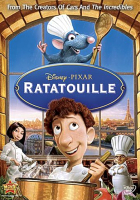
No comments:
Post a Comment